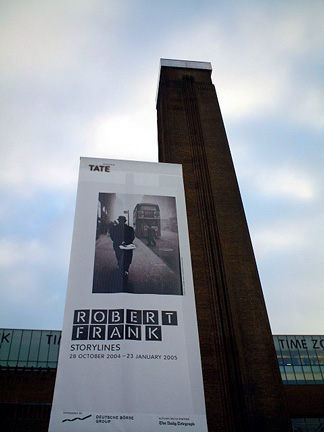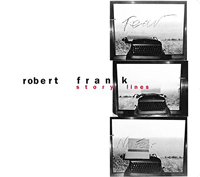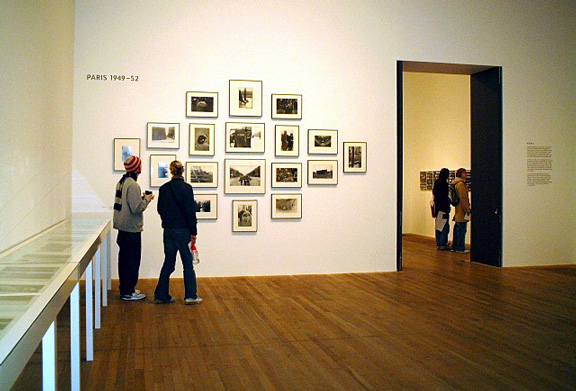Tate Modern
London
28 October 2004 – 23 January 2005
Robert Frank: Storylines
 Photo B. Sokolowska |
THIS extensive retrospective of Robert Frank spans over 50 years of the artistic career of one of the world’s most influential contemporary photographers. Exhibited photographs and films range from his early photographs taken in South America, to photographic collages from just a year ago. Two hundred and seventy works displayed in twelve rooms on the 4th floor of Tate Modern offer a fascinating insight into the rich and consistent evolution of Frank’s image-making.
Born in 1924 in Switzerland, Robert Frank migrated to the United States in 1947. Disappointed with his job as fashion photographer for Harper’s Bazaar, he embarked on a photographic journey to Peru and Bolivia. Displayed in the exhibition as pages from the book made by the artist, these photographs demonstrate the importance he attached to sequencing his images. They also reveal Frank’s interest in the human condition, the main theme underlying all his work.
Frank’s romantic photographs of Paris which follow a theme of flowers, contrast with his sombre images of London. A keen observer of human nature and social condition, Frank focused his attention on the extremes of the English class system photographing dark, self-absorbed, figures of bankers, oblivious to coalmen working just a few metres away. Moreover, a sense of menacing isolation is enhanced by the ever present fog. His stark photographic essay about Ben James, a miner, from a declining mining community in South Wales is an honest and compassionate story devoid of sentimentality.
Frank’s gradual disenchantment with the traditional structure of a narrative as beginning, middle and end led him to arrange his European photographs Black White and Things, in sequences according to a personal and poetic narrative following its own inner logic.

See also: Robert Frank: Storylines, hardcover, 240 pages, Publisher: Steidl. ISBN 3865210414
At this time Frank also started to question and dismantle the structure of the photographic image, a process which he continued throughout his career. A shift from classically composed photographs to spontaneous and dynamic snapshots is evident in the photographs Frank took in 1950s America. Travelling on a Guggenheim Fellowship he took twenty-eight thousand photographs in two years, presenting an outsider’s candid and perceptive view of American society. Eighty-three images published in The Americans, regarded today as a milestone in the history of photography, met with harsh criticism in America. Not only was this for exposing social and racial tensions in troubled times, but also because of Frank’s spontaneous and unconventional style. Included in the exhibition are proof sheets, which add a personal dimension to his photographic journey across the country and reveal the rhythm and method of his work.
In his 1958 series New York Bus, Frank pushed the boundaries of composition even further, releasing the still image from its static nature. Captured in motion, from a New York bus, his photographs of people standing on the pavement or crossing the street acquire a cinematic quality. Considering the way Frank’s image-making was evolving and in particular his strong interest in movement and sequencing, his shift from still photography to film-making was a logical step. In 1959 he put away his Leica and devoted the next ten years to film.
Several semi–documentary films included in the exhibition have a loose, narrative structure focusing on the artist and those around him. The frequent inclusion of his earlier photographs in his films questions the nature of memory, which exists only in photographs, a reality otherwise lost.
In the seventies Frank returned to still photography making Polaroids layered with text, recording his personal world and everyday life. His latest works, The Memory for the Children, combines text with images into complex colour collages. They are a reflection on passing time, family and returning to one’s roots. Exhibited in the same room as Frank’s early photographs these images complete the story of a photographic journey leading from the outside world, to a private, inner and personal sphere of experience.
Basia Sokolowska

Photo B. Sokolowska
See also:
Copyright © 1997-2026 Marek Grygiel / Copyright for www edition © 1997-2026 Zeta-Media Inc.